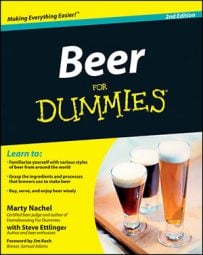A choice of beer usually depends on time and place. Whatever beer satisfies on a hot summer’s afternoon hardly suffices on a cold winter’s night. A beer you choose to be the last one of the evening might not be the one you start the evening with.
Different beers are best enjoyed according to the time of day or the season (that’s why breweries produce seasonal beers). Sometimes the best occasion for having a beer is nothing more than just enjoying a great beer.
Picking beers for before and after dinner
Stretching out the party? Try the following ideas for the beginning and end of dinner.
Aperitifs
Light- to medium-bodied, tart, and well-hopped (bitter) beers make good before-dinner drinks with their appetite-whetting capabilities. Here are some examples:
A dry, well-hopped Pilsner (the beer equivalent to the ubiquitous dry white wine, Chardonnay)
Berliner Weisse
California Common Beer (Steam Beer)
India Pale Ale
American Pale Ales
Belgian Gueuze or Lambic (fruited beers, such as Kriek or Framboise, are only for those who like cranberry juice or other fruit juices as an aperitif)
Flanders Red Ale
After-dinner drinks
Postprandial, or after-dinner, beers should be lightly carbonated and light- to medium-bodied. Here are some examples:
Brown Ale/English Mild Ale
British Bitters
Kölsch
Flanders Oud Bruin/Brown Ale
Nightcaps
Nightcap beers are generally big bodied and robust, with fairly high alcohol contents — hence their suggested use with late-night samplings on full stomachs. You can try these with dessert (or even in place of it):
Barleywine
Old Ale
Doppelbock
Eisbock
Belgian Strong Ale
Russian Imperial Stout
Scotch Ale
Trappist/Abbey Ales
Any beer aged in a bourbon barrel
These sweet, dark, strong beers are often what go best with chocolate.
Serving beer according to the season
One of the best things about craft breweries is that they like to produce different beers throughout the year, according to the season. Some beers are made only at certain times of the year, while others, available year-round, just have a natural taste link to a particular season.
Just as you wouldn’t want to drink a rich, heavy beer with a high alcohol content on a hot summer afternoon, you may not enjoy a light, spritzy beer on a winter’s evening. Here are some suggestions for beers to try as the calendar pages turn:
Winter: These beers tend to be darker and medium- to full-bodied, and they tend to contain higher levels of alcohol. Often brewed with spices, fruits, and herbs, they add to the celebratory spirit of this time of year. They also make good gifts. Try Barleywine, Belgian Strong Ale, Eisbock, Imperial Stout, Old Ale, Scotch Ale, Spiced beers, and Wassail.
Spring: The brewing industry has traditionally created its maltier beers for this season. Try Belgian Dubbel, Belgian Tripel, Bière de Garde, Bock, Doppelbock, Maibock, Porter, and Stout.
Summer: Summer beers should be light-colored, light- to medium-bodied, and spritzy. These beers can be served cold but not cold enough to numb the palate. Try Berliner Weisse, Blonde Ales, Cream Ale, Fruit Beer, Kölsch, Pale Ale, Pilsner, Saison, Weizenbier, and Witbier.
Fall: These beers are good midrange ones, neither light nor especially dark, neither light-bodied nor heavy-duty. Alcohol content is only a percent or two higher than in the summer beers. Try Amber Ale, Brown Ale, India Pale Ale, Oktoberfest/Märzenbier, Porter, Rauchbier, and Schwarzbier.

